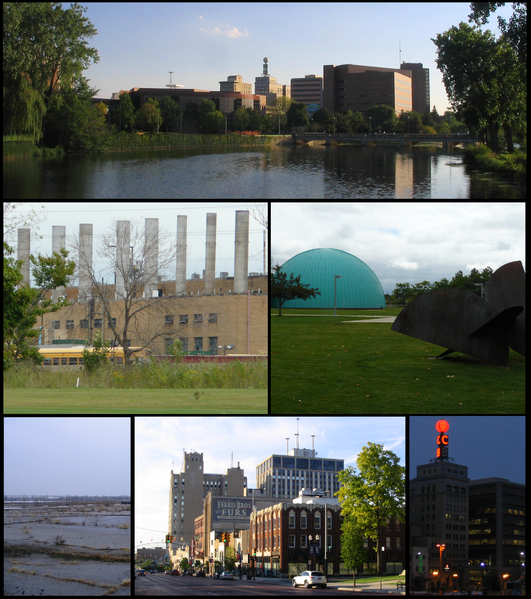Brownfields
“Brownfield sites are abandoned or underused industrial and commercial facilities available for re-use.”
– Wikipedia
How the hell did the entire cities of Flint and Detroit become brownfields sites?
-Socotra

(From Top Left: Downtown skyline as seen from the a bridge over the Flint River on the campus of University of Michigan- Flint, GM Powertain and the Swartz Creek Golf Course, Longway Planetarium, Brownfields former site of Buick City, South Saginaw Street, and the Citizen’s Bank “Weather Ball.” Photo montage from Connor Coyne/Blueskiesfalling).
I have a list of things to accomplish down at The Farm. Nothing particularly taxing- I realize that things that require ladders and a sure and steady gait are going to have to wait. First chore is a trip to visit the aquatic center on the south end of town and see what the facility looks like, and go from there.
I was going to launch into a big story about the microcosm of the Michigan economic malady, captured in the demise of the once bustling city of Flint. I toyed with the idea of taking you on a visit to the Nation’s Gun Show at the Dulles Expo Center. The three day event apparently sold out most of the inventory in the first day of the show, and protestors are out front screaming.
I can’t do it. A pal is going out there this morning, and he will report back on what he sees.
I am going to stick by my guns, if I may be permitted the term, and finish off Flint. I have been passing through the town for business and pleasure for nearly fifty years. If anyone cares, the city was the birthplace of General Motors, the site of the Sit Down Strike of 1936-37, which resulted in the triumph of the UAW over the corporate bosses.
Flint- or really Davidsonville- was the boyhood home of documentary propagandist Michael Moore, who has a loopy sort of sense of humor that extends to the manufacture of artificial fact in the interest of higher truth. Moore’s family was a part of the blue-collar middle class of the General Motors workforce that then-constituted the bulk of the civic enterprise of the city. Like me, he was an actual UAW member and worked on the line.

(Seal of the City of Flint. Motto: “Strong, Proud).
His first big splash was the 1989 mockumentary “Roger and Me,” in which he ambushed GM Chairman Roger Smith. The film provoked controversy, since Moore played fast and loose with the chronological record of what happened to his home town in the decade of the 1980s, when the auto industry started the nose-dive that is about to reach bottom seventy miles south in Detroit.
It was the whole chicken-and-egg thing and Michael put his big beefy embrace around GM as the evil villain.
Critics at the time said the documentary was a gonzo attack on capitalism, and Pauline Kael said she felt guilty about laughing at parts of it. Roger Ebert took an opposing view, saying that Moore’s manipulation of the timeline of Flint’s decay was justified on artistic grounds.
I certainly understand the chip on Moore’s shoulder about the whole thing. Flint is a disaster. The city described in “Roger and Me” had shed 30,000 jobs in GM’s downsizing. That naturally includes the ancillary businesses that supplied the behemoth- AC Sparkplugs, for one, and smaller firms like Flint Boxmakers, a corrugated paper business that made my pal Tom’s family wealthy for three generations.
Gone now. And the lost-jobs count is now 80,000. They were solid Union jobs that were shipped to Mexico or Canada, or replaced by non-union workers in Kentucky who build a better product.
By the 2000 census, the city had swindled to 124,000 residents. By 2010, the population slipped to just over a 100,000. A reverse migration, similar to the one that brought workers from the upper south to Michigan was draining away a vibrant middle class, leaving behind those who could not leave of their own volition.
I carry the same sort of chip that Moore does about the death of the system that made industrial Michigan the wonder of the world, and not one of its laughingstocks. I don’t have a great deal of sympathy for Roger Smith or the other idiots who drove the company into the ground, but I have to temper that with the suspicion that Union intransigence made the decline a suicide pact. They say now that GM is a pension and medical company that also manufactures a few cars.
I remember thinking at the time: this couldn’t be happening, can it? Damn, it isn’t right!
Capital does not care. It could make more money elsewhere and it did. Flint’s mayor and Roger Moore could wave they hands at Saginaw Bay and command the water not to rise all they wish. The great lakes will do what they do, rise or fall, without the assistance of man.
Flint first slipped into Emergency Manager country in 2002, and has rattled around in between democracy and state-imposed fiscal austerity ever since. The Emergency returned in 2011, and the UAW no longer was the primary adversary, since the plants were long gone. The gauntlet was picked up by public sector organized labor, the backbone of what is left of union power in a city that has imploded.
Oh well. I could rattle on about what happens when you obligate yourself to pay more in pensions and operating expenses than you take in, or the effect of single-party rule and the corruption that goes along with it. But in the end, at least at the civic level, the books have to be balanced.
In order to accommodate the declining tax base, Flint has got to come up with the money to raze vast swaths of abandoned homes and factories to tailor the cost of maintaining the infrastructure to those who remain. There is even a new term for the wasteland that remains afterwards: “Brownfields.”
I am just as outraged as Moore about that, but what can one do? There is nothing left to tax.
That is what is about to happen to Detroit. It has taken longer to get there, but of course the Motor City had much further to fall.
It is tempting to extrapolate the decline of these two linked American icons to something else, but our central government still has the ability to print its own money, and Mr. Bernanke at the Fed and Mr. Geithner at Treasury have committed to manufacturing a lot of it for the foreseeable future.
For good or ill, the USA is still in better shape than much of the rest of the world. Of course, when the tipping point is reached, it will make for interesting times, won’t it?
I wonder when that is going to be? Like Michael Moore, I may have my timelines confused, but at some point, the books are going to get balanced whether we like it or not.

(Theater poster for Moore’s mockumentary).
Copyright 2012 Vic Socotra
www.vicsocotra.com
